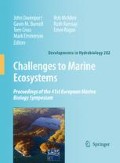Abstract
The problem of overexploitation and unsustainability is a major issue in global fisheries. Marine reserves or protected no-take zones have been suggested as a possible solution that would maintain yield and protect stocks indefinitely. A key factor in the effectiveness of a marine reserve-fishery system is the rate of exchange of biomass between reserve and fishery: if the rate of exchange is too low then the fishery is not viable, but if the rate of exchange is too high then stocks may be exploited unsustainably and the reserve is rendered ineffective. The rate of exchange is determined by both the physical design and shape of the reserve, and the movement and dispersal behaviour of both the adult and larval-stage fish. Previous models looking at optimal reserve design usually only consider a diffusive population scale movement and dispersal, even though most animal movement is more realistically modelled as being correlated at the individual level. In this article, a deliberately simple simulation of a theoretical marine reserve-fishery system is used to demonstrate the danger of making predictions using only a population-level simplistic diffusive movement model. Further predictions based on the population average of a more realistic correlated movement model are also shown to be inaccurate. This result is due to both the high levels of individual variability in movement behaviour, and the heterogeneity of the environment. This suggests that in future studies, individual-based (rather than population-level) simulations and models are likely to give more useful insights into the dynamics of the marine fishery environment.
Access this chapter
Tax calculation will be finalised at checkout
Purchases are for personal use only
Preview
Unable to display preview. Download preview PDF.
References
Benhamou, S., 2004. On the expected net displacement of animals’ random movements. Ecological Modelling 171: 207–208.
Bovet, P. & S. Benhamou, 1988. Spatial analysis of animals’ movements using a correlated random walk model. Journal of Theoretical Biology 131: 419–433.
Codling, E. A., N. A. Hill, J. W. Pitchford & S. D. Simpson, 2004. Random walk models for the movement and recruitment of reef fish larvae. Marine Ecology Progress Series 279: 215–224.
Codling, E. A., J. W. Pitchford & S. D. Simpson, 2007. Group navigation and the ‘many wrongs principle’, in models of animal movement. Ecology 88: 1864–1870.
Gerber, L. R., L. W. Botsford, A. Hastings, H. P. Possingham, S. D. Gaines, S. R. Palumbi & S. Andelman, 2003. Population models for marine reserve design: a retrospective and prospective synthesis. Ecological Applications 13: S47–S64.
Girard, C., S. Benhamou & L. Dagorn, 2004. FAD: fish aggregating device or fish attracting device? A new analysis of yellowfin tuna movements around floating objects. Animal Behaviour 67: 319–326.
Hoare, D. J., I. D. Couzin, J.-G. Godin & J. Krause, 2004. Context-dependent group size choice in fish. Animal Behaviour 67: 155–164.
Mardia, K. V. & P. E. Jupp, 1999. Directional Statistics. Wiley, Chichester.
Neubert, M. G., 2003. Marine reserves and optimal harvesting. Ecology Letters 6: 843–849.
Okubo, A. & S. Levin, 2001. Diffusion and Ecological Problems: Modern Perspectives. Springer, New York.
Ollason, J. G., J. M. Yearsley, K. Liu & N. Ren, 2006. Modelling the behaviour of individuals and groups of animals foraging in heterogeneous environments. In Boyd, I., S. Wanless & C. J. Camphuysen (eds), Top Predators in Marine Ecosystems. Cambridge University Press, Cambridge: 294–309.
Pauly, D., V. Christensen, S. Guenette, T. J. Pitcher, U. R. Sumaila, C. J. Walters, R. Watson & D. Zeller, 2002. Towards sustainability in world fisheries. Nature 418: 689–695.
Pelletier, D. & S. Mahevas, 2005, Spatially explicit fisheries simulation models for policy evaluation. Fish and Fisheries 6: 307–349.
Pezzy, J. C. V., C. M. Roberts & B. T. Urdal, 2001. A simple bioeconomic model of a marine reserve. Ecological Economics 33: 77–91.
Pitchford, J. W. & J. Brindley, 2001. Prey patchiness, predator survival and fish recruitment. Bulletin of Mathematical Biology 63: 527–546.
Pitchford, J. W., A. James & J. Brindley, 2005. Quantifying the effects of individual and environmental variability in fish recruitment. Fisheries Oceanography 14: 156–160.
Righton, D., J. Metcalfe & P. Connolly, 2001. Electronic tags reveal different behaviour of North and Irish Sea cod. Nature 411: 156.
Roberts, C. M., J. A. Bohnsack, F. Gell, J. P. Hawkins & R. Goodridge, 2001. Effects of marine reserves on adjacent fisheries. Science 294: 1920–1923.
Rodwell, L. D. & C. M. Roberts, 2004. Fishing and the impact of marine reserves in a variable environment. Canadian Journal of Fisheries and Aquatic Sciences 61: 2053–2068.
Rodwell, L. D., E. B. Barbier, C. M. Roberts & T. R. McClanahan, 2002. A model of tropical marine reserve-fishery linkages. Natural Resource Modeling 15: 1–34.
Rodwell, L. D., E. B. Barbier, C. M. Roberts & T. R. McClanahan, 2003. The importance of habitat quality for marine reserve-fishery linkages. Canadian Journal of Fisheries and Aquatic Sciences 60: 171–181.
Sladek Nowlis, J. C. & C. M. Roberts, 1997. You can have your fish and eat it, too: theoretical approaches to marine reserve design. Proceedings of the 8th International Coral Reef Symposium 2: 1907–1910. Smithsonian Tropical Research Institute, Panama City, Panama.
Sladek Nowlis, J. C. & C. M. Roberts, 1999. Fisheries benefits and optimal design of marine reserves. Fishery Bulletin 97: 604–616.
Watson, R., J. Alder & C. Walters, 2000. A dynamic mass-balance model for marine protected areas. Fish and Fisheries 1: 94–98.
Author information
Authors and Affiliations
Corresponding author
Editor information
Editors and Affiliations
Rights and permissions
Copyright information
© 2008 Springer Science+Business Media B.V.
About this paper
Cite this paper
Codling, E.A. (2008). Individual-based movement behaviour in a simple marine reserve—Fishery system: why predictive models should be handled with care. In: Davenport, J., et al. Challenges to Marine Ecosystems. Developments in Hydrobiology, vol 202. Springer, Dordrecht. https://doi.org/10.1007/978-1-4020-8808-7_5
Download citation
DOI: https://doi.org/10.1007/978-1-4020-8808-7_5
Publisher Name: Springer, Dordrecht
Print ISBN: 978-1-4020-8807-0
Online ISBN: 978-1-4020-8808-7
eBook Packages: Biomedical and Life SciencesBiomedical and Life Sciences (R0)

